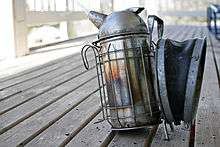Bee smoker

A bee smoker (usually called simply a smoker) is a device used in beekeeping to calm honey bees. It is designed to generate smoke from the smouldering of various fuels, hence the name.
Action and usage

The fact that smoke calms bees has been known since ancient times; however, the scientific explanation was unknown until the 20th century and is still not fully understood. Smoke masks alarm pheromones, which include various chemicals, e.g., isopentyl acetate [1] that are released by guard bees or bees that are injured during a beekeeper's inspection. The smoke creates an opportunity for the beekeeper to open the beehive and work while the colony's defensive response is interrupted. In addition, smoke initiates a feeding response in anticipation of possible hive abandonment due to fire. When a bee consumes honey the bee's abdomen distends, making it difficult to make the necessary flexes to sting. (The latter has always been the primary explanation of the smoker's effect, since this behavior of bees is easily observable.)
Smoke is of limited use with a swarm, partly because swarms have no honey stores to feed on. It is usually not needed, either, since swarms tend to be less defensive as they have no home to defend, and a fresh swarm will have fed well at the hive it left behind.
Design and operation of a traditional smoker

Smokers have been used in beekeeping for millennia, beginning perhaps with just a smouldering stick or a simple pan for burning. Beekeepers also used various bellows as originally employed by smiths or other workers.
Moses Quinby, the first commercial beekeeper in the United States, is credited with the invention of the modern single-handheld smoker (1875), with a bellows attached to a tin burner. Encyclopædia Britannica mentions T. F. Bingham of Farwell, Michigan, USA as the inventor of the smoker "most used in America and in the United Kingdom." His design was based on that of Quinby.
Many types of fuel can be used in a smoker as long as they are natural and uncontaminated with harmful substances. These fuels include hessian, burlap, pine needles, corrugated cardboard, paper egg cartons, and rotten or punky wood. Some beekeeping supply sources also sell commercial fuels like pulped paper and compressed cotton.
The fuel in the smoker's burner smoulders slowly because there is only a small amount of oxygen inside, until a squeeze of the bellows provides a blast of fresh air. In this way the fuel is used more sparingly than in an open pan, and one load of fuel may last for several hours, or even days (if it is extinguished and rekindled again later). To calm the bees, the smoke must not be hot.
There is a great variety of modifications to the basic design. As the burner can get very hot, as a safety guard against burns it is often placed into the second, outer can (making the smoker double wall). Alternatively, the burner may be surrounded with a protective wire grid.
References
- ↑ Harris, Jeffrey W.; Woodring, Joseph (September 1999). "Effects of dietary precursors to biogenic amines on the behavioural response from groups of caged worker honey bees (Apis mellifera) to the alarm pheromone component isopentyl acetate". Physiological Entomology. pp. 285–291. doi:10.1046/j.1365-3032.1999.00141.x.
External links
| Wikimedia Commons has media related to Bee smokers. |
- Non-English catalog of various smokers
- Spanish smokers collection In the catalogue of the EMAM Aula Apicola Municipal fron Azuqueca de Henares/ Guadalajara/Spain.